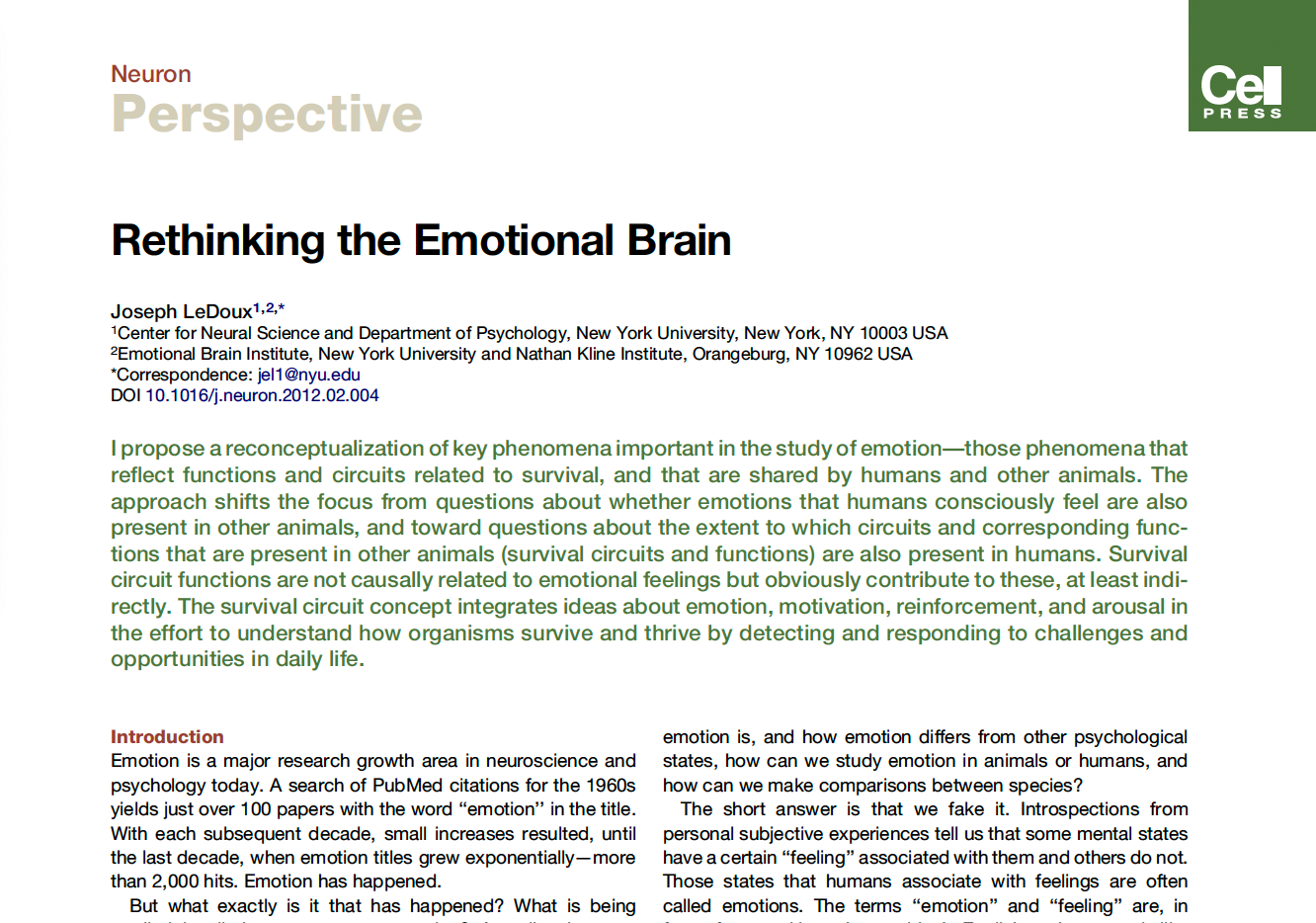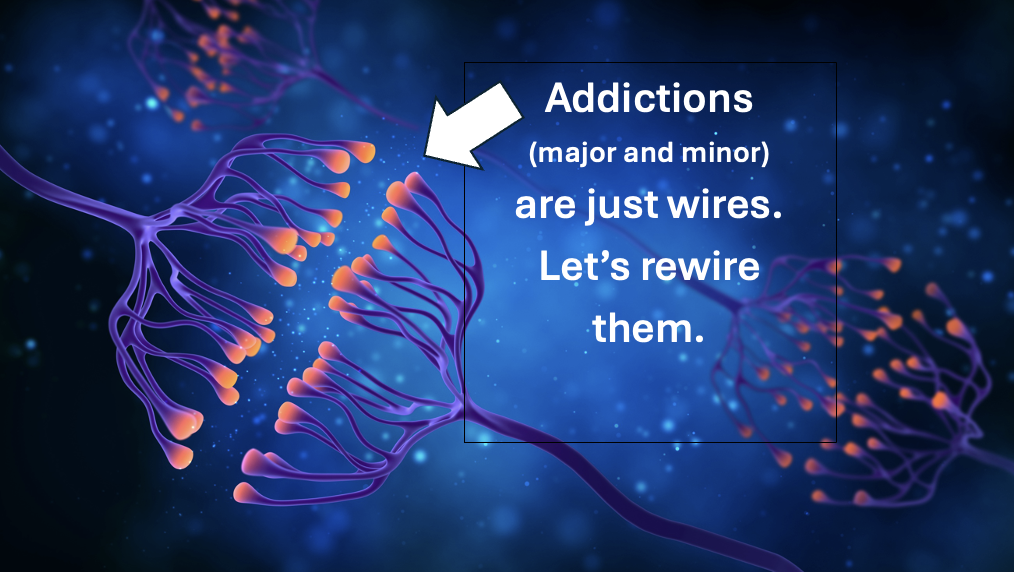Research was published in 2012 identifying brain circuits that drive maladaptive behaviors and addictions. As this literature on Survival Circuits is not well known (only 2258 have cited it), a quick review may be helpful to anyone treating or experiencing addictions – that is, most of us.
At EBT, we had already developed skills to rewire these circuits, principally because EBT Scientific Director Igor Mitrovic, MD, as a Professor of Physiology, knew all about them, given his role in teaching physiology to medical and pharmacy students at UCSF.
One circuit collides with another
We taught participants that the brain changed through associative learning. When a fight-or-flight circuit was activated, it functioned like super glue, integrating that fight-or-flight drive with whatever sensations, emotions, thoughts, behaviors, or states were co-activated at that time. After that, even small stressors could activate that wire, and the brain would reflexively unleash strong biochemical drives to repeat that response. Yet, I was stunned when I saw an elegant article by Joseph LeDoux, Professor of Neural Science and New York University Director of the Emotional Brain Institute, come across my desktop.
Dr. LeDoux articulated an entirely new way to think about emotions. He differentiated basic emotions that direct us to meet our needs (what we call homeostatic emotions) and those feelings that Survival Circuits trigger of intense arousal (allostatic emotions) and biochemical mayhem, taking the thinking brain offline so we reflexively do whatever the circuit tells us to do. Hence, the circuits lead to addictive use disorders . . . or are "addiction circuits."
A brain-based, actionable way to treat addiction
By seeing addiction through the lens of neuroscience, the out-of-control response is the "tail end" of a fight-or-flight Survival Circuit. Now, some 13 years after the publication of Dr. LeDoux's article, its application has been seriously limited.
For example, in the current psychiatric diagnostic manual, addiction is defined based on specific characteristics, and the same is true for 12-step programs. Both were developed before neuroplasticity was proven. Both have wide followings and many benefits but have not integrated the plasticity of the neural root cause of the problem – Survival Circuits – into their conceptual base.
It's time that changes, as by looking at addiction through the lens of rewiring Survival Circuits, we discover new ways to empower all of us – as small or large, we all sport, have sported, or will sport some of these wires – to use the experience of addiction to become healthier, happier, more loving individuals. What follows are a few ideas to start you along the pathway of rebirthing how you think about addiction.

#1 Rebirth: We can be addicted to anything.
Meredith, a woman who was in her late 40s when she joined one of my EBT Support Groups, commented, "I always thought of addicts as 'those other people,' but I have a Survival Circuit that careens me out of control, and it's ruminating. Once I start, I can't stop." She was right. That Survival Circuit can glom on to anything, take away our power, and block our joy.
#2 Rebirth: There is never just one addiction.
Although any of us can find one specific Survival Circuit more debilitating than another and choose to EBT it first, addiction is never a one-circuit problem. Most of us find a Habit Circuit, a specific behavior driven by these wires, to be first in our lineup of circuits to rewire. However, these wires are best friends to one or more emotional circuits. For example, a Depression Circuit triggers a Habit Circuit. Anyone under stress will likely activate a relationship wire, which often causes so much stress that it triggers a Habit Circuit or two. The problem is not one circuit but a family of them.
#3 Rebirth: Addictions come in all sizes and strengths.
Rewiring these circuits requires activating them, staying present to the strong emotions they trigger, and delivering a new message that updates the old one while the circuit is open. For lasting change (less chance of the dreaded "reinstatement" of the circuit), repeated and precise experiences targeting the wire and the related fear memories and coactivated Core Circuits (basic unconscious beliefs) are needed.
Some circuits are bigger and stronger than others, and in EBT, we classify them as 5 Circuits, 4 Circuits, and 3 Circuits. In other words, any wire that produces a strong enough biochemical surge that the thinking brain goes offline and reflexive repetition of the response that follows can be damaging enough and rewarding enough (all Survival Circuits spark the reward center) that we can think about them as an addiction.
Rather than listing "behaviors we need to change" more adaptively, we can list Survival Circuits on our "to-do" list. By clearing the neurobiological cause of the response, habit change can be easier and more lasting.
EBT and de-stigmatizing addiction
To the extent that the science of Survival Circuits becomes integrated into psychotherapy and 12-step programs, it will not change the seriousness of some strong and powerful addictions that cause suffering and death. The more quickly the reward is delivered and the stronger it is, the more addictive and the sooner the brain collapses into an allostatic set point of self-destruction. In treating these addictions, a comprehensive program is needed, including many layers of support from pharmaceuticals to 12-step programs to psychotherapy.
However, by thinking about addiction based on neural circuits, the self-judgment and confusion can stop. When we do not acquire a set of super-charged emotional resilience tools early in life, we have no way of processing our toxic emotions that can quickly turn into addictions. All of us need these tools for prevention if not treatment. EBT provides them.
Apart from a comprehensive addiction program for detox, there is a need for those who are "graduates" to learn EBT for both effective emotion regulation and to rewire any remaining circuits still biting at our heels. Psychotherapists who learn about Survival Circuits and the EBT rewiring tools can't help but integrate them into their practices – because people change faster, and the rewiring typically sticks.
Yes, we all have these wires. How freeing!
Best of all, what a relief to not worry that we might be addicted to everyday patterns like scrolling on our iPhones, numbing out, being perfect, bursts of outrage, emotional meltdowns, overthinking everything, as well as pharmaceuticals, recreational drugs, alcohol, and the most common addiction of all: food. The answer is "YES!" The solution is to figure out if it is a 3 Circuit, a 4 Circuit, or a 5 Circuit and EBT it.
We're all in this beautiful world together, with so much planetary and personal stress that these wires find their way into our brains, but they don't have to stay there. We can EBT them with pride, love, and joy.

